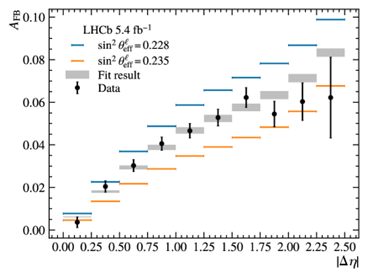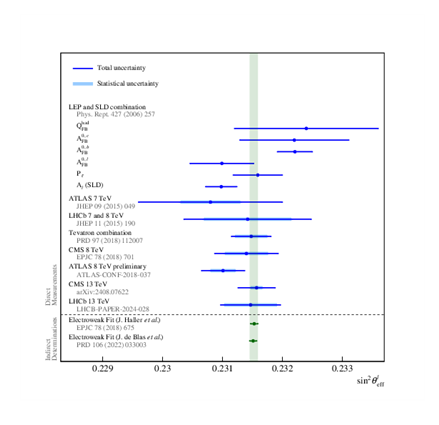LHCb measures the effective leptonic weak mixing angle

Image 1: The forward-backward asymmetry in the pp→Z/γ*→μ+μ– process measured in ten intervals of the difference of the muon pseudorapidities.
In the Journal of High Energy Physics [JHEP 12 (2024) 026; arxiv:2410.02502]), the LHCb collaboration reports a measurement of the effective leptonic weak mixing angle (sin2θleff), the parameter which is involved in the unification of the electromagnetic and weak forces. The result was obtained from the analysis of the forward-backward asymmetry in the pp→Z/γ*→μ+μ– process measured in intervals of the difference of the muon pseudorapidities. Key contributions to the measurement were made by Liverpool researchers Abbie Chadwick, David Hutchcroft, and Tara Shears.
The forward-backward asymmetry is related to how often a produced matter particle travels in a similar (“forward”) direction as an incoming matter particle involved in a collision. For this the parton (quark and antiquark) distributions inside the proton need to be known precisely. At the LHC the Z bosons used in this analysis are produced mainly in the collisions of (valence) quarks with high momentum and (sea) antiquarks with low momentum. The Z bosons then decay into a pair of muons. The LHCb geometrical acceptance is ideal for this measurement. The incoming quark direction, needed to define the sign of the asymmetry, can be identified correctly 90% of the time.
Image 1 shows the forward-backward muon asymmetry AFB measured by LHCb for 10 different pseudorapidity Δη intervals. The measured values are compared with predictions for different values of sin2θleff shown with blue and orange mini-lines. The predictions were adjusted to the measured experimental numbers and the result is shown with green mini-lines. The final value of 0.23152±0.0044(stat.)±0.00005(syst.)±0.00022(theory) for sin2θleff was obtained in this way. The LHCb result is compared in Image 2 with the results of other experiments and the indirect determination obtained in electroweak fits in which all of the other electroweak measurements were used except those of direct sin2θleff measurements. The significant difference between direct measurements and the indirect determination could indicate a manifestation of physics beyond the Standard Model. The LHCb result is consistent with other direct measurements and with the prediction from global electroweak fits.

Image 2: The LHCb result is compared with the results of other experiments and the indirect determination obtained in electroweak fits in which all the other electroweak measurements were used except those of direct sin2θleff measurements.
Read more on the LHCb public web page, in the paper, and in the CERN seminar presentation.